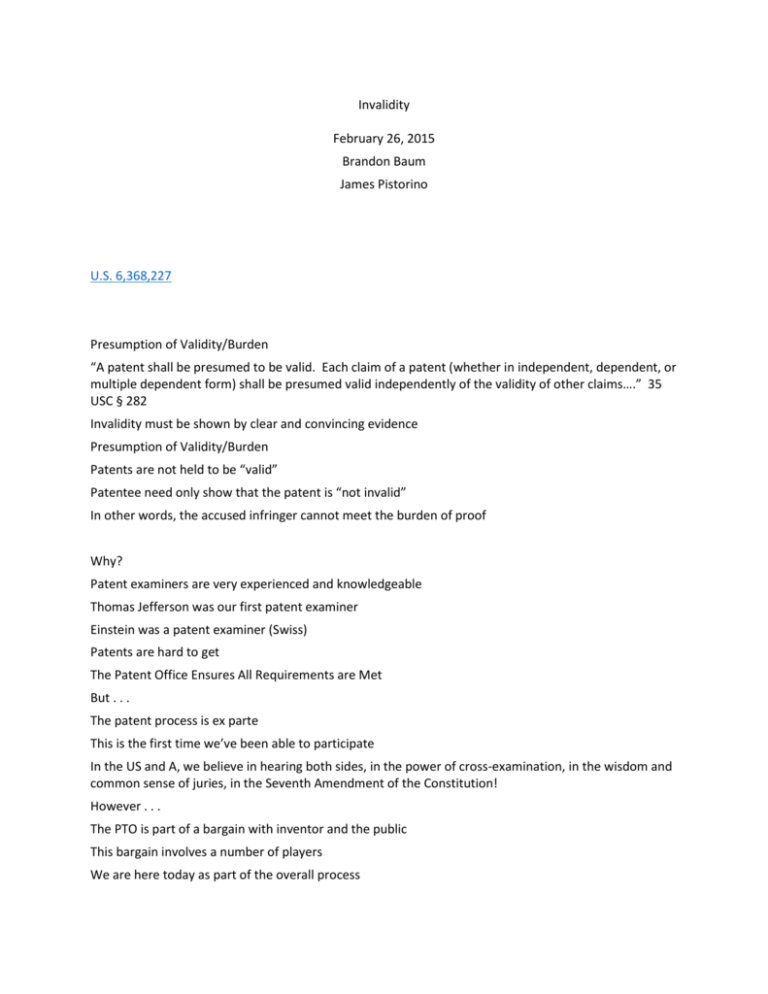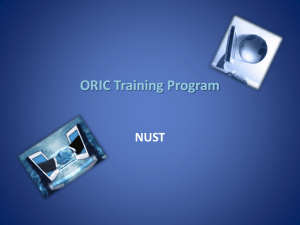Invalidity February 26, 2015 Brandon Baum James Pistorino U.S.
advertisement

Invalidity February 26, 2015 Brandon Baum James Pistorino U.S. 6,368,227 Presumption of Validity/Burden “A patent shall be presumed to be valid. Each claim of a patent (whether in independent, dependent, or multiple dependent form) shall be presumed valid independently of the validity of other claims….” 35 USC § 282 Invalidity must be shown by clear and convincing evidence Presumption of Validity/Burden Patents are not held to be “valid” Patentee need only show that the patent is “not invalid” In other words, the accused infringer cannot meet the burden of proof Why? Patent examiners are very experienced and knowledgeable Thomas Jefferson was our first patent examiner Einstein was a patent examiner (Swiss) Patents are hard to get The Patent Office Ensures All Requirements are Met But . . . The patent process is ex parte This is the first time we’ve been able to participate In the US and A, we believe in hearing both sides, in the power of cross-examination, in the wisdom and common sense of juries, in the Seventh Amendment of the Constitution! However . . . The PTO is part of a bargain with inventor and the public This bargain involves a number of players We are here today as part of the overall process Only now do the sides have equal bargaining power Invalidating Patents Serves the Public “There is a stronger public interest in the elimination of invalid patents than in the affirmation of a patent as valid.” Nestier v. Menasha, 739 F.2d 1576 (Fed. Cir. 1984) “It is as important to the public that competition should not be repressed by worthless patents, as that the patentee of a really valuable invention should be protected in his monopoly” Lear v. Adkins, 395 U.S. 653, 664 (1969) Challenge Individual Claims Invalidate claims, not patents (inventorship exception) Claim-by-claim analysis Independent and dependent claims are considered separately So even if independent claim 1 of the stool patent is invalid, if dependent claim 2 recites “the stool of claim 1 wherein the seat portion is comprised of graphene molecules,” claim 2 may still be valid as novel Invalidate using “prior art” Prior art = knowledge that existed at or before the time of invention or application for the patent The patent system rewards those who advance the useful arts through the disclosure of new and nonobvious inventions That which is not new, or is an obvious variation on what was known, does not promote the useful arts Egbert – Public Use Samuel Barnes invented double corset-springs. Barnes let his “intimate friend” wear publicly (under her clothes). “The inventor slept on his rights for eleven years.” Egbert – Public Use Held: Bar. Public use, though unobserved, is a bar to a claim “if its inventor sells a machine of which his invention forms a part, and allows it to be used without restriction of any kind, the use is a public one." Egbert – Public Use What if Barnes and his “intimate friend” had been married at the time of the use? On sale bar Frequently involves offers for sale by others, who tried and failed in the field Sometimes involves offers for sale by patentee, who later claims the thing offered was not yet “ready for patenting” Look for early investors, failed competitors, your own product people. Prior Art Searches and Defenses Always investigate the accused product The accused product or a prior version may be prior art or lead to other prior art Hardly any ideas are totally new Cases from the Federal Circuit hold that if the accused product was on sale before the critical date, no claim construction is necessary to determine invalidity Important in pharma and mechanical/electrical cases Trolls can be sloppy Prior Art Searches and Defenses Consider yourself a detective Software for non-web software, programmers typically keep trophy copies WayBack Machine – Internet Archive eBay, Weird Stuff Warehouse, Halted Good sources of old copies of software, electronics, etc. It is always best to get a physical product/working copy for trial Prior Art Searches and Defenses LinkedIN Good place to find former employees of companies If an engineer worked on a product, he is likely to have one Libraries Old magazines are a great source for articles and particularly advertisements about prior art products Prior Art Searches and Defenses People Most people are helpful and want to tell a story about something they developed Giving people a little money never hurt, sign people up as consultants and pay them for their time Ask who they would call You will almost always find someone who was a pack rat and kept everything Prior Art Searches and Defenses Be Careful If you contact a prior art person and they have their own patents, you may prompt them to bring their own suit Some people will see your contact as the lottery ticket and try to extort money to "remember" the facts Electronic Prior Art Websites An electronic publication, including an on-line database or Internet publication, is considered to be a "printed publication" within the meaning of 35 U.S.C. § 102(a) and (b) if it was accessible to persons concerned with the art. In re Wyer, 655 F.2d 221 (Fed. Cir. 1981) The Wayback Machine (www.archive.org) Software Software products are prior art as of the date they were first installed or released. In re Epstein, 32 F.3d 1559 (Fed. Cir. 1994). Let’s talk about cats . . . Go to Google Groups Applying the prior art to the patent-in-suit We know what qualifies as prior art under 102 How to show the patent-in-suit is not valid in light of the prior art? What is Enough to Anticipate? A claim is “anticipated” if every element in the claim is shown or described in the prior art reference arranged as in the claim. Therasense v. Becton, Dickinson, 593 F.3d 1325, 1332 (Fed. Cir. 2010). “That which will infringe, if later, will anticipate if earlier.” Knapp v. Morss, 150 U.S. 221 (1893). 103 - Obviousness 35 USC 103(a) “A patent may not be obtained though the invention is not identically disclosed or described as set forth in section 102 of this title, if the differences between the subject matter sought to be patented and the prior art are such that the subject matter as a whole would have been obvious at the time the invention was made to a person having ordinary skill in the art to which said subject matter pertains. Patentability shall not be negatived by the manner in which the invention was made.” 103 - Obviousness 103 - Obviousness 4 Factual Inquiries Graham v. John Deere 1. What is the scope and content of the prior art? 2. What are the differences between the prior art and the claims at issue? 3. What is the level of ordinary skill in the pertinent art at the time the invention was made? 4. Does any objective evidence of nonobviousness exist? 4 Factual Inquiries Graham v. John Deere 1. What is the scope and content of the prior art? Anything that qualifies under 35 USC 102 4 Factual Inquiries Graham v. John Deere 2. What are the differences between the prior art and the claims at issue? How are the claims different than the prior art? 4 Factual Inquiries Graham v. John Deere 3. What is the level of ordinary skill in the pertinent art at the time the invention was made? A higher level of ordinary skill means an invention is more likely to be obvious. 4 Factual Inquiries Graham v. John Deere 4. Does any objective evidence of nonobviousness exist? A lengthy list of factors that help us avoid hindsight. Also called “secondary considerations,” though by no means are they “secondary” in importance Under the old (pre-KSR) rules, the Examiner could not combine references unless there was some express teaching, suggestion or motivation to do so Level of Ordinary Skill (PHOSITA) (1) the levels of education and experience of persons working in the field; (2) the types of problems encountered in the field; and (3) the sophistication of the technology. Significance of PHOSITA In Daiichi Sankyo Co v. Apotex , (Fed.. Cir. July 11, 2007) the district court determined that a PHOSITA would be a pediatrician or a general practitioner who has experience treating ear infections. Therefore, a 1986 article regarding the effectiveness of a compound similar to the patented compound in treating ear infections was outside the scope of the prior art because it was written for otologists, not pediatricians and other general practitioners. The Federal Circuit disagreed, holding that a person skilled in the art would be an expert in formulating new pharmaceuticals and a specialist in ear treatments. Accordingly, the patent would have been obvious and therefore invalid. Scope and Content What is the relevant art? All arts reasonably related to the invention, including analogous arts—arts to which the subject matter of the invention pertains. Use PTO classifications if they help you Analogous Art In order to be considered as prior art, the references must be reasonably related to the claimed invention of that patent. A reference is reasonably related if it is in the same field as the claimed invention or is from another field to which a person of ordinary skill in the field would look to solve a known problem. N.D. Cal Model Instruction 103(a) Obviousness What counts as 103(a) art? Anything that qualifies as art under 102 102(a): patent, printed publication, known or used by others 102(b): patents one year before filing. 102(e): prior patent application, even though not publicly known. 102(f): disclosures made to the patentee, even if not publicly known. 102(g): prior inventions not abandoned, suppressed or concealed. Significance of PHOSITA in preparing your obviousness case Make sure the expert you retain will qualify under your definition of a PHOSITA Where patent is being stretched to cover technology not originally contemplated by inventors, how does that impact the definition Patentee wants to argue that “Judge will tell you that this patent is written for a PHOSITA of digital communications technology, so defendant is wrong to say we are stretching this hearing aid patent.” Hindsight Not Permitted The point in time that is critical for an obviousness determination is at the time the invention. “To imbue one of ordinary skill in the art with knowledge of the invention in suit, when no prior art reference or references of record convey or suggest that knowledge, is to fall victim to the insidious effect of a hindsight syndrome wherein that which only the inventor taught is used against its teacher.” W.L. Gore & Assocs., Inc. v. Garlock, Inc., 721 F.2d 1540, 1553 (Fed. Cir. 1983). Combination not required A single prior art reference combined with the knowledge of one of ordinary skill can render an invention obvious if there was a motivation to modify the reference. See SIBIA, 225 F.3d 1349, 1357. Patentee’s Response - secondary considerations of nonobviousness Commercial success Long felt need Failure of Others Copying Unexpected results Acceptance of licensees Patentee’s Response Beef stew Blind man and the elephant Def’s expert is not one of ordinary skill, expert has extraordinary skill Def’s expert never made the combination, nor did the prior art authors Obvious? Don’t Forget Inventorship... Patent application must name all and only inventors Mis/non-joinder will invalidate patent Choice of asserting mis/non-joinder or seeking connection of inventorship Burden on challenger, by clear and convincing evidence
![Introduction [max 1 pg]](http://s3.studylib.net/store/data/007168054_1-d63441680c3a2b0b41ae7f89ed2aefb8-300x300.png)




